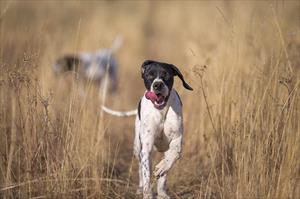Pointer Running

Testicular tumors are the most common genital tumors found in male dogs. Tumors can grow in one or both testicles. Most types of testicular tumors are malignant. Usually this means that they are cancerous and have the potential to spread and harmfully change the surrounding tissues. Cancerous tumors can also metastasize (spread) to other organs throughout the body. The good news is that although testicular cancer in dogs is technically malignant, unlike other types of malignant tumors, these tend to occur at an older age (i.e. average 10 years of age) and metastasis to other organs is rare.
Dogs can develop three main types of testicular cancer (although numerous uncommon cancers can also occur): 1) seminoma, 2) Leydig or interstitial cell tumor, and 3) Sertoli or sustentacular cell tumor. More than one of these three types can occur in one cancerous testicle, and both testicles can be cancerous but have different types of testicular cancer.
Clinical Signs
When a dog has testicular cancer, one of his testicles may look or feel abnormal. The affected one may be larger than the normal testicle, or it may have a firm, sometimes painful mass inside that you can feel. If both testicles are cancerous, they may both seem larger than normal; the testicles may be painful; or there might be masses.
Some dogs appear to only have one testicle. This likely means that during puppyhood, only one testicle descended or dropped normally, and the other testicle remained in his abdomen or belly. This happenstance is known as cryptorchidism. Cancer of the undescended or cryptorchid testicle is common but will not be obvious by just looking at your pet. Sertoli cell tumors and seminomas are the most common types of testicular cancer found in an undescended testicle.
Other signs of cancer can include weight loss, poor appetite, abdominal/belly pain, or a mass in the belly. Some testicular cancers, such as Sertoli cell tumors, produce estrogen, a hormone more commonly associated with female dogs. Dogs with testicular tumors that produce estrogen may develop enlarged mammary glands or breast tissue; hair loss on the dog’s trunk; or dark discoloration to the skin. In some cases, estrogen-producing testicular tumors can also affect the bone marrow, resulting in low red blood cell, white blood cell, and platelet counts. In such cases, pallor and acting tired from anemia, excessive bleeding and bruising, and/or fever and infections may occur. Leydig cell tumors can produce an excess amount of testosterone. In such cases, a dog may develop swelling on his rear near his anus, which may be due to a hernia or enlargement of the perianal glands surrounding the anus.
It is important to understand that initially many dogs will not show obvious signs. Also of importance is that not all of the clinical signs described are specifically associated with testicular cancer. Numerous other causes may be the culprit, so further testing may be needed to determine why your dog is having such unusual changes.
What to do if you Suspect Testicular Cancer
If you think your dog might have testicular cancer, your regular veterinarian will perform a physical examination and check over your dog’s testicles. A rectal examination will check your dog’s prostate gland and feel for enlarged lymph nodes. Palpation or feeling structures inside your dog’s abdomen is also common, as well as checking your dog’s gums and listening to his heart and lungs.
If cancer is suspected, x-rays of the belly and chest may be needed to search for more clues of cancer or spread to other organs. Lab work may be done to make sure your pet’s internal organs are functioning correctly or to see what hormones are circulating in the bloodstream. Sometimes an abdominal ultrasound will be needed to look for an undescended testicle or organ metastasis.
Treating Testicular Cancer
Castration, or basic neutering, is the recommended treatment of choice. Both testicles need to be removed because cancer may be present in both, even if only one is obviously affected. If a pet is cryptorchid, intra-abdominal surgery will be needed to remove the testicle in the abdomen as well as surgery to remove the normal one.
A pathologist can assess the testicles after they are removed to determine the type of cancer. Sometimes chemotherapy or radiation can be performed, but the effectiveness will depend on the type and severity of cancer. If your veterinarian is not comfortable treating the type of cancer, you may be referred to a veterinary oncologist.
If no evidence of metastasis has occurred and the pet isn't displaying any major tumor-related clinical signs, surgery is often the only treatment needed and your pet will be cured. Only about 15% of testicular tumors metastasize, so the cure rate after surgery is extremely high. Pets that are severely affected by testicular tumors, such as those with bone marrow disease, have a much poorer prognosis. This means that even with surgery, very sick pets may not survive. The sooner surgery can be performed after noticing clinical signs or a change in the testicles, the better your pet’s chances of cure will be.